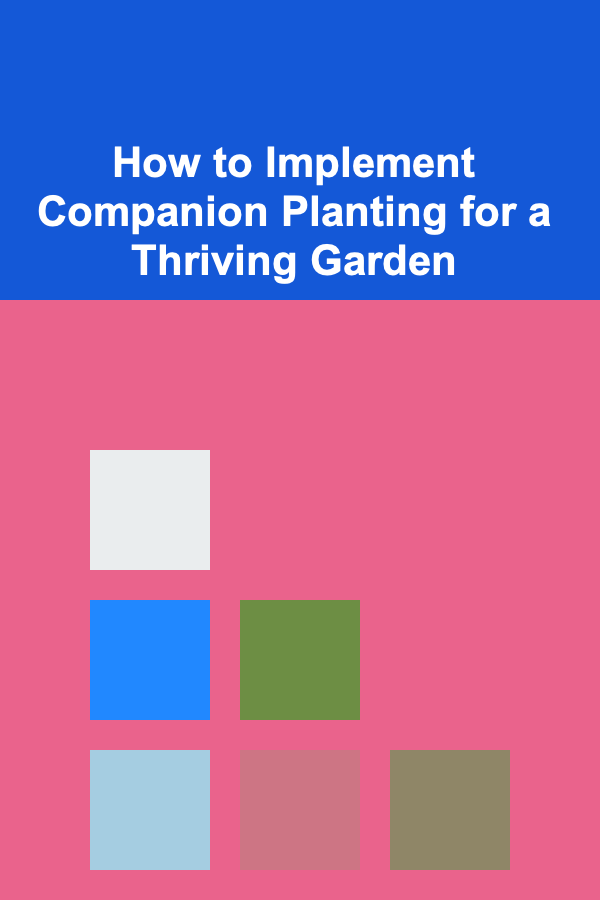
How to Implement Companion Planting for a Thriving Garden
ebook include PDF & Audio bundle (Micro Guide)
$12.99$11.99
Limited Time Offer! Order within the next:

Companion planting is an ancient agricultural practice that involves strategically placing plants together in order to enhance growth, reduce pests, and improve overall garden productivity. This holistic approach not only promotes biodiversity but also fosters a more resilient ecosystem. In this comprehensive guide, we will explore the principles of companion planting, its benefits, specific pairings, and practical tips for implementing it successfully in your garden.
Understanding Companion Planting
1.1 What is Companion Planting?
Companion planting refers to the practice of growing different plants in proximity to each other to achieve various benefits. The concept is based on the idea that certain plants can help one another thrive by enhancing growth, repelling pests, or attracting beneficial insects. This method reflects the natural relationships found in ecosystems, where various species coexist symbiotically.
1.2 The Science Behind Companion Planting
Companion planting is grounded in both folklore and scientific research. Different plants release unique chemicals into the soil and air, which can affect nearby plants. Some key mechanisms include:
- Allelopathy: Certain plants produce substances that inhibit the growth of others. For example, black walnuts release juglone, which is harmful to many plants.
- Symbiosis: Some plants form beneficial relationships, such as legumes fixing nitrogen in the soil, which is then utilized by neighboring plants.
- Attracting Beneficial Insects: Flowers like marigolds attract pollinators and predators of common pests, enhancing the health of surrounding plants.
Understanding these interactions is crucial for effectively implementing companion planting techniques.
Benefits of Companion Planting
2.1 Pest Management
One of the primary advantages of companion planting is pest control:
- Natural Repellents: Strong-smelling plants (like basil and mint) can deter pests from more vulnerable crops.
- Trap Crops: Some plants can lure pests away from main crops. For instance, planting radishes can attract flea beetles, keeping them off cabbage.
This natural system reduces reliance on chemical pesticides, promoting a healthier garden environment.
2.2 Improved Growth and Yields
Companion planting can lead to increased plant vigor and productivity:
- Nutrient Sharing: Certain pairs of plants can utilize different soil nutrients, reducing competition for resources.
- Microclimate Creation: Tall plants can provide shade for shorter plants that prefer cooler conditions, extending their growing season.
By leveraging the strengths of various plants, gardeners can optimize yields and enhance overall garden health.
2.3 Soil Health Enhancement
Diverse plantings contribute positively to soil quality:
- Nitrogen Fixation: Leguminous plants like peas and beans enrich the soil with nitrogen, benefiting adjacent crops.
- Ground Cover: Plants like clover prevent soil erosion and promote moisture retention.
Healthy soil is foundational for sustainable gardening, and companion planting plays a key role in maintaining soil vitality.
Common Companion Plant Pairings
3.1 Vegetable Companions
Certain vegetables thrive when planted together:
- Tomatoes and Basil: Basil enhances the flavor of tomatoes and repels pests like aphids.
- Carrots and Onions: These two have complementary root structures and can confuse pests that target either crop.
Fostering these relationships can lead to better growth and reduced pest issues.
3.2 Herbs and Flowers
Incorporating herbs and flowers into vegetable gardens can be beneficial:
- Marigolds and Various Veggies: Known for repelling nematodes and other pests.
- Chives and Carrots: Chives deter carrot flies and enhance the growth of nearby carrots.
These combinations can create a vibrant, productive garden ecosystem.
Designing Your Companion Planting Layout
4.1 Garden Zones
Strategically organizing your garden into zones can optimize companion planting:
- Sunlight Zones: Group plants according to their sunlight needs, ensuring that taller plants do not shade shorter ones.
- Water Zones: Arrange plants based on their water requirements to prevent overwatering or drought stress.
Creating well-defined zones allows for efficient resource management and promotes healthy plant relationships.
4.2 Vertical Gardening Techniques
Utilizing vertical space encourages diverse plant arrangements:
- Trellises: Grow climbing plants like cucumbers alongside lower-growing plants like lettuce to maximize space.
- Hanging Baskets: Incorporate herbs in hanging baskets above raised beds, effectively utilizing vertical height.
Vertical gardening techniques can elevate the companion planting strategy, creating a dynamic and thriving garden environment.
Tips for Successful Companion Planting
5.1 Choosing the Right Plants
Not all plants are compatible; careful selection is critical:
- Research: Familiarize yourself with recommended companion pairings using reliable gardening sources.
- Local Conditions: Consider factors such as climate, soil type, and available sunlight to tailor selections.
A well-informed approach ensures that you choose effective companions for optimal results.
5.2 Spacing and Arrangement
Proper spacing can significantly affect plant health:
- Plant Density: Avoid overcrowding, which can lead to competition for light, water, and nutrients.
- Intercropping: Mix shallow-rooted and deep-rooted plants to utilize different soil layers efficiently.
Paying attention to spacing and arrangement supports healthy growth and maximizes the benefits of companion planting.
Case Studies: Successful Companion Planting
6.1 Home Vegetable Gardens
Many home gardeners report success with companion planting:
- Example: A gardener combines tomatoes with basil and marigolds, resulting in robust tomato plants that yield high-quality fruit while keeping pests at bay.
Documenting such successes can inspire others and highlight effective companion strategies.
6.2 Community Gardens
Community gardens often embrace diverse planting techniques:
- Example: A community project utilizes a variety of companion planting pairings, resulting in higher harvests and fewer pest problems across shared plots.
Collaboration in community gardens fosters knowledge sharing and enhances the gardening experience.
Challenges and Solutions
7.1 Identifying Incompatible Plants
Not all plants thrive together; identifying incompatibilities is crucial:
- Research Plant Relationships: Use resources to understand which plants should not be grown near each other (e.g., onions and peas).
- Trial and Error: Keep a record of what works and what doesn't in your garden to avoid future pitfalls.
Being proactive about potential incompatibilities will save time and resources in your gardening efforts.
7.2 Managing Competition for Resources
Competition for sunlight, water, and nutrients can hinder growth:
- Monitor Plant Performance: Regularly assess how plants are faring and adjust placements if necessary.
- Supplemental Feeding: Provide additional nutrients to struggling plants to ensure they remain healthy and productive.
Effective management of resources will support the health of all plants involved in your companion planting scheme.
Conclusion
Implementing companion planting can lead to a thriving garden filled with biodiversity, healthier plants, and improved yields. By understanding the science behind plant relationships, selecting appropriate companions, and thoughtfully designing your garden layout, you can harness the power of nature for a flourishing garden.
As you embark on your companion planting journey, remember to document your experiences. Learn from both successes and challenges to refine your techniques continuously. By embracing this holistic approach to gardening, you cultivate not just plants, but a deeper connection to the ecosystem around you. Happy gardening!
Reading More From Our Other Websites
- [Trail Running Tip 101] Best Post‑Run Stretching Sequences Tailored for Uneven Terrain Stress
- [Ziplining Tip 101] Best Zipline Gear & Equipment for a Safe & Comfortable Ride
- [Rock Climbing Tip 101] Dynamic vs. Static Moves: When to Power Through and When to Stay Controlled
- [Home Storage Solution 101] How to Declutter Your Bathroom with Space-Saving Storage Tips
- [Tie-Dyeing Tip 101] How to Create Tie‑Dye "Galaxy" Designs with Neon and UV‑Responsive Dyes
- [Beachcombing Tip 101] Preserving Ancient Relics: Safely Collecting and Caring for Beach Fossils
- [Home Rental Property 101] How to Handle Conflict with Landlords or Tenants
- [Weaving Tip 101] Beyond the Loom: Using Weaving to Build Focus, Patience, and Problem-Solving Abilities
- [Personal Financial Planning 101] How to Use Credit Cards Responsibly to Build Credit
- [Home Storage Solution 101] How to Incorporate Built-In Storage into Your Home Design

How to Create a Farmhouse Look on a Budget
Read More
How to Manage Your Pet's Weight and Prevent Obesity
Read More
How to Maximize Small Bedroom Space with Smart Solutions
Read More
How to Use Natural Cleaners for Your Appliances
Read More
Why You Should Evaluate and Update Your Organizing Systems
Read More
Understanding Calorie Deficit for Weight Loss: A Comprehensive Guide
Read MoreOther Products

How to Create a Farmhouse Look on a Budget
Read More
How to Manage Your Pet's Weight and Prevent Obesity
Read More
How to Maximize Small Bedroom Space with Smart Solutions
Read More
How to Use Natural Cleaners for Your Appliances
Read More
Why You Should Evaluate and Update Your Organizing Systems
Read More